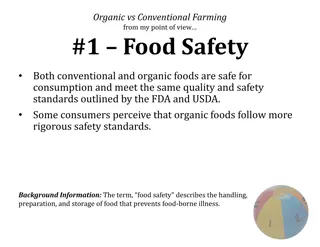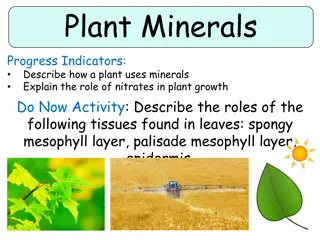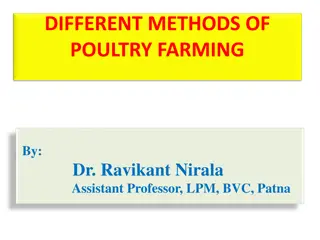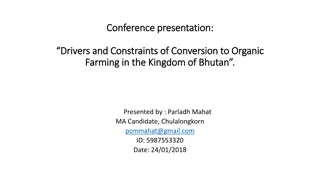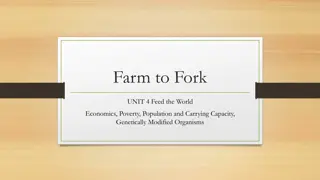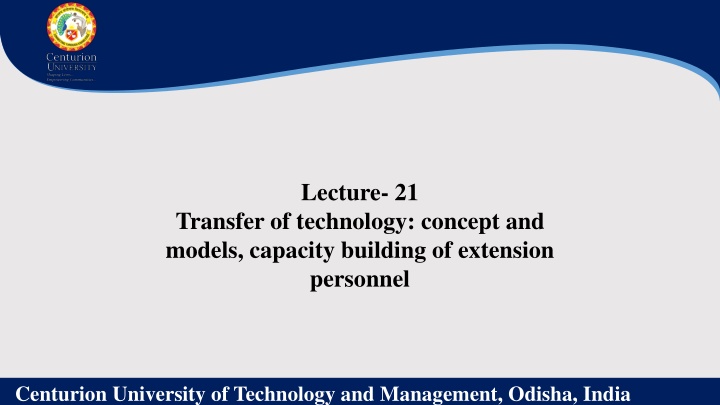
Transfer of Technology for Improved Farming Productivity
Technologies are essential for enhancing production potential and productivity in farming. Transfer of technology involves the dissemination, application, and adoption of scientific know-how to achieve improved production. Different models such as top-down and feedback models are used in technology transfer, with the farmer participatory model focusing on active farmer involvement. Capacity building plays a crucial role in strengthening individuals' skills and enhancing organizational performance to meet goals efficiently and sustainably.
Download Presentation

Please find below an Image/Link to download the presentation.
The content on the website is provided AS IS for your information and personal use only. It may not be sold, licensed, or shared on other websites without obtaining consent from the author. If you encounter any issues during the download, it is possible that the publisher has removed the file from their server.
You are allowed to download the files provided on this website for personal or commercial use, subject to the condition that they are used lawfully. All files are the property of their respective owners.
The content on the website is provided AS IS for your information and personal use only. It may not be sold, licensed, or shared on other websites without obtaining consent from the author.
E N D
Presentation Transcript
Lecture- 21 Transfer of technology: concept and models, capacity building of extension personnel Centurion University of Technology and Management, Odisha, India
Technologies are generated for their application in the appropriate field. This involves transfer of technology (ToT) which is one of the important functions of extension service. Transfer of technology is needed for improving the production potential and productivity in farming. The components of technology transfer are enlisted as under: i) Science or scientific know-how, ii) Dissemination, iii) Application or utilization, iv) Adoption and v) Improved production. Centurion University of Technology and Management, Odisha, India
Top-down-model (Conventional model) Salient features - Farmers act as passive recipients of technologies - No contact between farmers and scientists - Extension plays the role to persuade the farmers to adopt new technologies In this model, the client s views and problems are not given due importance which is an inherent problem of this model. Feedback model Salient features - Research values identification of target group and its problems. - Close interaction between research and extension systems. Centurion University of Technology and Management, Odisha, India
Research is carried out both at research farms and farmers fields - Researchers include extension personnnel and social scientists to have a holistic understanding of farmers problems. Farmer- back to- farmer model (Farmer participatory model) - An alternative to the two models discussed earlier. - Here the underlying assumption is that research must begin and end with the farmer. - The farmers must be incorporated as fully active members of the problem solving team Centurion University of Technology and Management, Odisha, India
Capacity building Capacity Building can be defined as "activities which strengthen the knowledge, abilities, skills and behaviour of individuals and improve institutional structures and processes such that the organization can efficiently meet its mission and goals in a sustainable way. Centurion University of Technology and Management, Odisha, India
Why capacity development is important? 1. Enhances Organizational and Individual Performance: Capacity building is essential for organizations and individuals to enhance their performance. It helps organizations to develop skills, knowledge, and abilities to better manage their resources, improve communication, and increase productivity. It also helps individuals to improve their skills and knowledge, which can lead to personal growth and development, better job opportunities, and career advancement. 2. Increases Efficiency and Effectiveness: Capacity building can increase the efficiency and effectiveness of organizations and individuals. It helps them to identify their strengths and weaknesses and develop strategies to Centurion University of Technology and Management, Odisha, India
3. Promotes Innovation and Creativity: Capacity building can promote innovation and creativity. It encourages organizations and individuals to think outside the box and come up with new ideas and solutions to challenges. This can lead to improved services, products, and processes, which can benefit the organization and the wider community. 4. Empowers Communities: Capacity building can empower communities to take control of their own development. It helps them to identify their needs and priorities, develop strategies to address them, and build their skills and knowledge to implement those strategies effectively. This can lead to increased self-reliance and sustainability. Centurion University of Technology and Management, Odisha, India
5. Facilitates Knowledge Transfer: Capacity building can facilitate knowledge transfer from one organization or individual to another. It helps to share best practices, lessons learned, and innovative ideas. This can lead to improved collaboration and partnerships, and ultimately, better outcomes. 6. Strengthens Resilience: Capacity building can strengthen the resilience of organizations and communities. It helps them to adapt to changing circumstances and to respond effectively to emergencies or crises. This can help to reduce the impact of disasters and other disruptions and to promote recovery and rebuilding. Centurion University of Technology and Management, Odisha, India
7. Builds Trust and Credibility: Capacity building can help to build trust and credibility among stakeholders. When organizations and individuals have the skills, knowledge, and abilities to carry out their work effectively, they are more likely to be trusted and respected by their peers, customers, and partners. 8. Enables Strategic Planning: Capacity building can enable organizations and individuals to carry out strategic planning effectively. With the right skills and knowledge, they can identify opportunities, set goals, and develop strategies to achieve them. This can help to ensure that resources are used effectively and efficiently. 9. Supports Change Management: Capacity building can support change management efforts. When organizations and individuals are equipped with the skills and knowledge to manage change effectively, they are better able to adapt to new circumstances and to implement new strategies and initiatives. Centurion University of Technology and Management, Odisha, India
10. Fosters Collaboration and Partnerships: Capacity building can foster collaboration and partnerships among organizations and individuals. When they have a common understanding of issues, challenges, and opportunities, they are more likely to work together effectively and to achieve shared goals. 11. Promotes Diversity and Inclusion: Capacity building can promote diversity and inclusion within organizations and communities. When individuals and organizations have the skills and knowledge to appreciate and value diversity, they are more likely to create inclusive environments that promote innovation and creativity. Centurion University of Technology and Management, Odisha, India
12. Improves Accountability and Transparency: Capacity building can improve accountability and transparency within organizations and communities. When individuals and organizations have the skills and knowledge to monitor and evaluate their performance, they are better able to identify areas for improvement and to communicate their successes and challenges to stakeholders. 13. Supports Sustainability: Capacity building can support sustainability efforts. When individuals and organizations have the skills and knowledge to manage their resources effectively, they are better able to promote environmental, social, and economic sustainability. Centurion University of Technology and Management, Odisha, India


